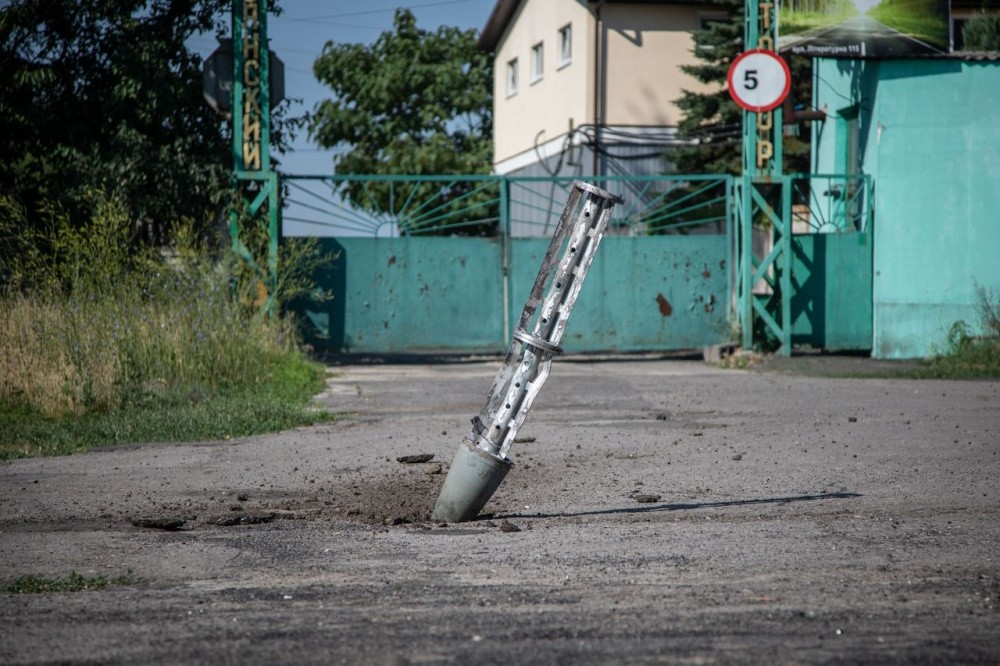U.S. Made Cluster Munitions Fuel Ukrainian Counter Offensive

Newly delivered, American-made cluster munitions have given fresh impetus to Ukraine’s campaign to retake territory captured by Russia, after weeks of little progress. Ukrainian soldiers say they have used the cluster bombs—which release dozens of smaller bomblets and can cause devastation over a broader area than ordinary artillery shells—to hit concentrations of Russian infantry, groups of vehicles and other targets, clearing the way for ground advances.
Kyiv’s counteroffensive operations have struggled in the face of wide minefields and Moscow’s superior air power, which have impeded large-scale efforts to use Western-supplied tanks and armored vehicles to reach and punch through lines of entrenched Russian forces. While the cluster bombs alone won’t tilt the battlefield balance of power decisively in Ukraine’s favor, soldiers say they have helped them retake Russian positions that they had struggled to reach.
The munitions have been coupled with a change in tactics, which has allowed Ukrainian troops to advance to within striking distance of the main Russian defensive lines in some places. That progress has come with substantial casualties. We explain the technology behind cluster munitions and why they have raised humanitarian concerns.
“The cluster bombs are good. They are effective,” said Capt. Anatoliy Kharchenko, commander of a reconnaissance company. “But the Russians are dug in deep, and they learn quickly.” Kharchenko said Russian trenches can be 7 feet deep and that the Russians are adapting by spreading their troops more thinly to avoid heavy losses. Recent fighting around the village of Robotyne, southeast of Zaporizhzhia city, has demonstrated the effectiveness of the new weapon in Ukraine’s arsenal.
In late July, a platoon was pinned down east of the village, taking heavy Russian fire. The unit radioed its commander, asking to withdraw. He told the platoon to take cover instead. Cluster bombs flew overhead. One soldier said he heard what sounded like rain, followed by chaos on Russian radio channels.
“They were yelling, ‘We have lots of wounded. We need to evacuate. We’re pulling back,’” the Ukrainian soldier said. The platoon moved forward to capture the Russian position, soldiers said.
Ukraine still hasn’t reached the most formidable Russian defenses, a series of trenches, tank traps and other barriers. Military experts say Ukraine likely will need its Leopard 2 tanks and other Western-provided armored vehicles to push through those lines. To preserve those vehicles, which it was losing in numbers in minefields in early June, the Ukrainian military switched tactics. Now, infantry—bolstered by reserves called in from other units—are leading the advances through minefields on foot.
In concert with the strategic changes, soldiers said, Ukrainian forces now believe they have a chance for a breakthrough.
How a cluster bomb works
- A common type of cluster munition is launched from land or dropped from a plane and opens midair to release tens or hundreds of smaller explosive munitions, or submunitions.
- The container ejects the submunitions, commonly by combining an explosive charge and a spin mechanism.
- When the fuze of each submunition is triggered, on the ground or in the air, it explodes.
- Submunitions don’t always explode and can pose a hazard long after conflicts end.
- Last week, as the 16-member platoon of Oleksandr, a 33-year-old infantry private, advanced toward a Russian position, it came under heavy fire from Russian machine guns. The Ukrainians were forced to retreat.
Then Ukraine hit the tree line hiding the Russian forces with cluster munitions. Brush and grass caught fire. When the next assault began, Oleksandr could see the Russians he was firing at, who were no longer concealed in the scrub. His platoon captured the position, killing about 12 Russians and taking several others captive. The prisoners had suffered concussions and burns from the cluster bombs, he said.
“With the cluster bombs, you fire three times and the trees totally collapse,” he said, adding that there was less incoming fire after the cluster attack. Because the munitions cause damage across a wide area, he said, they didn’t need to be as accurate to be effective. “Even if you miss a little, it still works,” he said. Lt. Gen. Ben Hodges, a former commander of the U.S. Army in Europe, said the U.S. sent cluster munitions instead of more howitzer ammunition, which is running low in the West. He expected cluster bombs would be more effective. They were designed for an army that was outnumbered, as Ukraine is now. “Part of the way you deal with mass formations is with this scatterable munition,” he said. “If you’re sitting in an open trench, you’re going to pay a huge price due to these things.”
Videos posted recently on social media show Russian soldiers with half a dozen small wounds after Ukrainian cluster munition attacks. Hodges said the bombs also fit with what he saw as a shift in Ukrainian strategy to target Russian artillery pieces. “These will really knock out artillery as long as they can reach it,” he said.
The weapons are banned by more than 100 countries, and the U.S. decision to send them to Ukraine was heavily criticized by humanitarian groups. Not all the bomblets detonate right away, and they sometimes injure people who come upon them years later. Russian forces have been using cluster munitions throughout the war: The white shell casings that carry them stick out of fields around the country. Ukraine also used them at times last year, according to a United Nations report.
A soldier in an artillery unit who has fired the cluster munitions said they were most effective in fields, where they dispersed over a wider area. “Cluster munitions are important, but they’re not a turning point,” he said, adding that it was important to have different kinds of artillery for different situations. Usually, infantrymen said, artillery units fire a mix of different munitions at a Russian position before they advance on foot. Still, the human cost of the progress around Robotyne has been steep. “We’re demining the fields with bodies,” said a platoon commander from another of the newly formed, Western-trained brigades. “It’s awful.”
Oleksandr Pershin, an infantryman, said that in the fields east of Robotyne, the ability of cluster munitions to wipe out tree cover was invaluable. During a recent assault on a Russian position, he said, there was no tree left above waist height. “Everything else was destroyed,” he said, “mostly from the cluster munitions.” Once his unit had taken that position, he said, they tried to keep pushing through the trees toward the next Russian line. For 24 hours, they made a series of assaults but kept getting pushed back, as the Russians sprayed them with machine-gun fire.
Eventually, they were ordered to dig trenches where they were. While Pershin, 34, was digging, a rocket landed near him, spraying him with shrapnel and sending him to the hospital. As he spoke, his arm was in a sling and bandages covered wounds all over his body. Of 60 men in the assault, he said, 45 had been injured or killed.










